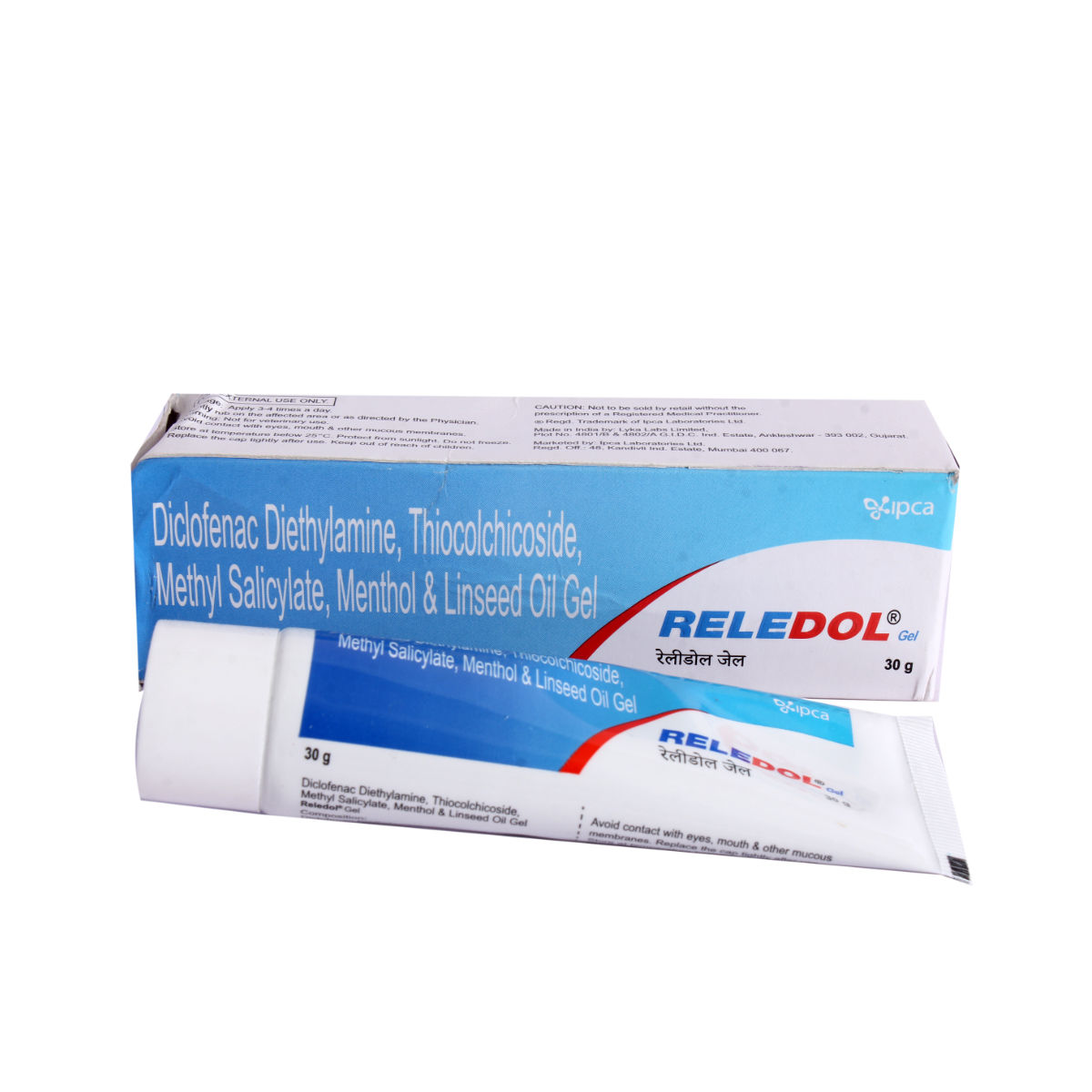Diclofenac+thiocolchicoside+menthol
About Diclofenac+thiocolchicoside+menthol
Diclofenac+menthol+thiocolchicoside belongs to the class of medications called ‘analgesics’ used in the treatment of pain, muscle spasms and joint stiffness. It is used for pain relief in various inflammatory conditions such as osteoarthritis (degenerative bone disease), rheumatoid arthritis (an autoimmune disease that causes joint stiffness), ankylosing spondylitis (a rare type of arthritis that affects the spine), etc.
Diclofenac+menthol+thiocolchicoside contains Diclofenac, Thiocolchicoside, and Menthol. Diclofenac works by reducing prostaglandins production (chemical substances that cause pain and inflammation) at the affected site and reduce pain. Thiocolchicoside reduces muscle spasms and pain. Menthol acts as a pain reliever. It produces a cooling sensation to the skin when applied followed by warming up. These effects interfere with the pain signal and reduce pain.
You should use this medicine exactly as prescribed by the doctor. The common side-effects of Diclofenac+menthol+thiocolchicoside are burning sensation, redness, itching, irritation, and numbness at the application site. These side-effects are usually mild and temporary. However, if any of these side-effects persist or get worse, inform your doctor immediately.
It is not recommended to take Diclofenac+menthol+thiocolchicoside if you are allergic to any contents of it. Before using Diclofenac+menthol+thiocolchicoside, inform your doctor if you have heart disease, a history of heart attack, a stroke, high cholesterol, high blood pressure, diabetes, or a smoking habit. It is not recommended for use in children and pregnant women. It should be used with caution in breastfeeding mothers and elderly people.
Uses of Diclofenac+thiocolchicoside+menthol
Medicinal Benefits
Diclofenac+menthol+thiocolchicoside is used to treat pain associated with various inflammatory conditions such as osteoarthritis, rheumatoid arthritis and ankylosing spondylitis. It has a quick onset of action. It can also reduce muscle spasms, swelling, inflammation and stiffness. It helps you to perform your daily activities without much problem.
Directions for Use
Storage
Side Effects of Diclofenac+thiocolchicoside+menthol
- Skin redness
- Itching
- Irritation
- Burning sensation
- Numbness at the application site
Drug Warnings
Diclofenac+menthol+thiocolchicoside is for use on the skin only. Avoid contact of this medicine with the eyes, nose or mouth. If the medicine accidentally gets into your eyes, rinse with water thoroughly. Avoid exposure to heat after applying Diclofenac+menthol+thiocolchicoside as this may increase the risk of side-effects. Avoid using sun lamps and tanning beds. Do not use a heating pad immediately after applying Diclofenac+menthol+thiocolchicoside. Do not use this medicine before or immediately after the activities such as bathing, exercising, and swimming. Do not cover the treated area with a dressing, unless advised by the doctor.
Drug Interactions
Drug-Drug Interactions: No interactions found.
Drug-Food Interactions: No interactions found.
Drug-Disease Interactions: No interactions found.
Drug-Drug Interactions Checker List:
Safety Advice

Alcohol
safe if prescribedDiclofenac+menthol+thiocolchicoside may not interact with alcohol.

Pregnancy
unsafeDiclofenac+menthol+thiocolchicoside is not recommended for pregnant women as it may cause harmful effects on the unborn baby.

Breast Feeding
cautionDiclofenac+menthol+thiocolchicoside should be used with caution in breastfeeding mothers as the safety and efficacy in this population have not been established. So, please consult a doctor.

Driving
safe if prescribedDiclofenac+menthol+thiocolchicoside may not affect your ability to drive.

Liver
safe if prescribedDiclofenac+menthol+thiocolchicoside is probably safe when used in patients with liver diseases.

Kidney
safe if prescribedDiclofenac+menthol+thiocolchicoside is probably safe when used in patients with kidney diseases.

Children
unsafeDiclofenac+menthol+thiocolchicoside is not recommended for use in children.
Habit Forming
Diet & Lifestyle Advise
- Perform gentle activities like 20-30minutes of walking or swimming. Physical activity helps in strengthening muscles and relieves joint stiffness.
- Perform yoga as it may help in improving joint flexibility and pain management.
- Maintain a healthy weight by performing regular low-strain exercises and eating healthy food.
- Get adequate sleep as resting the muscles can help in reducing inflammation and swelling.
- Follow heat or cold therapy, apply a cold or hot compress on the joints for 15-20minutes regularly.
- De-stress yourself by meditating, reading books, taking a warm bubble bath or listening to soothing music.
- Acupuncture, massage, and physical therapy may also be helpful.
- Eat food rich in antioxidants such as berries, spinach, kidney beans, dark chocolate, etc.
- Foods containing flavonoids help in reducing inflammation. These include soy, berries, broccoli, grapes and green tea.
- Avoid smoking and alcohol consumption.
Special Advise
- If you are undergoing heart surgery, you should not use Diclofenac+menthol+thiocolchicoside before or right after the surgery. So, let your doctor know that you are taking Diclofenac+menthol+thiocolchicoside before undergoing any surgery.
- Check the labels carefully before taking any medicine as many over-the-counter medicines contain non-steroidal anti-inflammatory drugs (NSAIDs) as an active ingredient.
Patients Concern
Disease/Condition Glossary
Pain: It is a symptom triggered by the nervous system, causing uncomfortable sensations in the body. Muscle spasm is the sudden involuntary contractions of the muscle, which can be painful and uncomfortable. When the nerve impulses that control the muscle movements are damaged or interrupted, it could lead to muscle spasms. Symptoms include muscle tightness, joint stiffness, unusual posture, difficulty in moving, and pain in affected muscles and joints. Fatigue (weakness), stress, extreme heat or cold, infection, and tight clothing can trigger muscle spasms. Muscle relaxants and exercise can treat muscle spasms. Muscle relaxants sedate the muscle and help in inhibiting painful contractions. Whereas, exercise helps in muscle stretching to be less likely to spasm, tear and sprain.
FAQs
Diclofenac+menthol+thiocolchicoside is used to relieve pain, muscle spasms and joint stiffness.
Diclofenac+menthol+thiocolchicoside contains Diclofenac, Thiocolchicoside, and Menthol. Diclofenac is a nonsteroidal anti-inflammatory drug (NSAID). It works by reducing prostaglandins production (chemical substances that cause pain and inflammation) at the affected site and reducing pain. Thiocolchicoside is a muscle relaxant that can reduce muscle spasms and pain. Menthol acts as a pain reliever. It produces a cooling sensation to the skin when applied followed by warming up. These effects interfere with the pain signal and reduce pain. Together, Diclofenac+menthol+thiocolchicoside can effectively provide pain relief.
Diclofenac+menthol+thiocolchicoside is for external use (skin) only. Do not use it on skin rashes or lesions without discussing it with your doctor. Do not use any heating pads immediately after using the medicine. Do not use it before or immediately after activities such as bathing, exercising, or swimming.
The common side-effects of Diclofenac+menthol+thiocolchicoside are burning sensation, redness, itching, irritation, and numbness at the application site. These side-effects are usually mild and temporary. However, if any of these side-effects persist or get worse, inform your doctor immediately.
Diclofenac+menthol+thiocolchicoside should be used with caution in individuals with heart disease, a history of heart attack, or a stroke, high cholesterol, high blood pressure, diabetes, and smoking habit.
Diclofenac+menthol+thiocolchicoside is generally prescribed for short durations i.e. 7 days. However, if the symptoms still persist, stop using Diclofenac+menthol+thiocolchicoside and consult your doctor.








